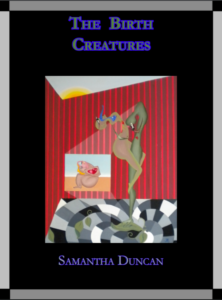 Review by Barbara Harroun
Review by Barbara Harroun
– Samantha Duncan’s intimate, inventive, and gloriously imaginative chapbook-length poem The Birth Creatures examines and gives new eyes and voice to the post-partum experience. Duncan, the author of the chapbooks One Never Eats Four (ELJ Publications, 2014) and Moon Law (Wild Age Press, 2012), explained the genesis of The Birth Creatures in a Blogging the Numinous interview with Julianna DiMicco:
The Birth Creatures came from a few places. I wanted to reclaim my own postpartum experience, which I felt had been downplayed and not taken very seriously by those around me. I also think not enough is said about how bizarre pregnancy and childbirth are, so I wanted to write something that reflected that. (https://bloggingthenuminous.com/?s=birth+creatures)
Imagistically rich and haunting, this poem leads readers into a house that blooms with dark wilderness. The fridge talks, the moon “who sideways glances come hithers/at me” (3), “a rhinoceros sits upright/like a thick gray throne/in the kitchenette corner where the bouncer was to go” (2) and “a peat bog/where the kitchen table was” (8). It is a space transformed, just as the brutal and mysterious process of laboring new life into the world transforms the speaker of the poem. In the course of the poem, she also labors a re-imagined, renegotiated sense of self into being. In Duncan’s skilled hands, each stanza leads us someplace unexpected—each stanza is a room we walk into and encounter something wholly unexpected and walk out of altered, changed—as the speaker of the poem is changed. From the poem’s beginning, it is clear we are journeying into a poem that relishes the tradition of magical realism:
at thirty-seven weeks
I wake in the night
a cypress tree has appeared in the corner roots bubbling under the wood
floor to the empty crib
you perch on its leafy flat-top head the life inside me now separate (1)
The Birth Creatures unfurls, and leads us down a deep and dappled, darkly shadowed path. This is a poem about the confines and expansiveness of time, consuming and being devoured, revolution and resurrection. The speaker of the poem is not without heat lightening bursts of humor:
consequently the moon has moved a third of itself inside
pompous belly stretching into bookshelves middle finger to Proust
and Dostoyevsky’s bio (7)
I admire greatly Duncan’s use of the canvas of the page, allowing the line breaks and indentations to make the poem come alive. The speaker’s voice is made more hushed, and alternately roars and reverberates through Duncan’s use of white space, her control in architecting a poem as she intends us to read it, hear it, and sit with it. She builds this poem without the use of punctuation, although this occurred to me only on my second reading. We are ensconced in the stanzas as is the speaker when she is “…/ pulled into the rhino / nestled in its crib of ribs / reminded of what I’ve missed // the deckled skin / of home” (10).
The Birth Creatures brought back to me, viscerally, the first three months following the birth of my two children. “revolution/ is the gist of it”(10), Duncan writes and it’s true. The Birth Creatures reveals how anticipating and actually living the reality of motherhood are two distinctly different entities. The baby arrives and all landscapes (temporal, physical, emotional and mental geographies) are violently transformed and known, trusted systems are overthrown. And yet, in finding our way through unmapped terrain, Duncan reveals there is magic all around us. In the home she’s created there is room enough for a rhino, a cypress tree, and even the moon. There is room for readers to reflect, room for remembering and reinventing, as we come to know the terrible wonder, wilderness, and beauty of laboring new life into being, ourselves included.
The Birth Creatures
by Samantha Duncan
Agape Editions—a Sundress Publications Imprint (2016), $free [ebook]
ISBN: 9781939675316
Barbara Harroun is an Assistant Professor at Western Illinois University. Her most recent work is forthcoming or appearing in Fiction Southeast, Watershed Review, Rappahannock Review, and Iron Horse Literary Review. Her favorite creative endeavors are her awesome kids, Annaleigh and Jack. When she isn’t writing, reading, or teaching, she can be found walking her beloved dog, Banjo, or engaging in literacy activism and radical optimism. She can be found at barbaraharroun.com.
